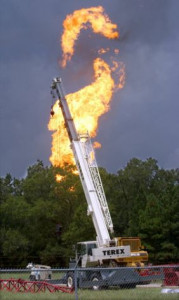At 4:00 a.m, an uncontrolled gas release and fire occurred at storage cavern of a salt cavern storage facility. Over a period of 6.5 days, the approximately 170 millions m3 of natural gas in the cavern was released and burned (at about 28 millions m3 par day). The fire eventually self-extinguished, and late on Aug. 26, installation of a blowout prevention valve was completed, effectively placing the well back under control.
The estimated replacement value of the cavern is in the range of $15 to $20 million. Also lost of gas worth a reported $36 million or more. Fortunately, no serious injuries or loss of life occurred, although many families living in the Moss Bluff area were inconvenienced by an evacuation that lasted several days.
The investigation determined that the initiating event was a separation of the 219 mm well string inside the cavern at or above the 1,135 m level. The reason for this breach event is unknown and the affected materials are not recoverable from the cavern. The storage was operating in normal de-brining mode where brine is withdrawn from the cavern as gas is injected. No unusual events occurred in the de-brining process and operator reports indicate that the system was performing normally.
When the brine level reached the point where the well string had separated, gas under pressure was able to enter the string, reach the surface and flow into the 200 mm above ground brine piping. The emergency shutdown (ESD) system in place on the brine piping off the wellhead assembly operated properly and closed with the detection of a change in pressure, flow and/or composition. The resulting mechanical forces or water hammer produced by the sudden surge of flow caused the 200 mm piping between the wellhead and the ESD valve to breach. The breach occurred at a location in the piping that had general wall loss due to internal corrosion. The extent of the internal corrosion of the brine piping was not expected due to the relatively short period of time it had been in service (installed and tested in 2000). The breach in the 200 mm, above-ground brine piping just west of the wellhead initially fueled the fire. Due to the location of the breach, the gas release and fire were directed downward at the base of the wellhead.
On the 20/08, the entire wellhead assembly separated from the casings due to the extreme radiant heat and was ejected to the side. The fire self-extinguished for a brief period of time (approximately 28 seconds). Gas then began escaping vertically through the 0.5 m production casing. Operating procedures were reviewed and found to be adequate and appropriately followed. Valve positions were confirmed and found to be correct. A thorough review of operator logs and employee interviews did not reveal evidence that procedural or human error contributed to the event.




